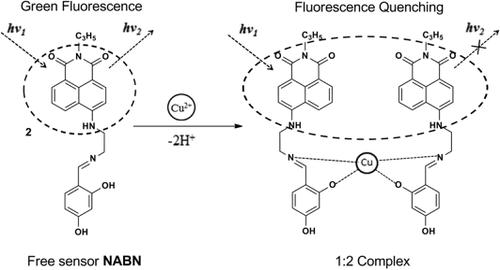当前位置:
X-MOL 学术
›
J. Chin. Chem. Soc.
›
论文详情
Our official English website, www.x-mol.net, welcomes your feedback! (Note: you will need to create a separate account there.)
A fluorescence “on–off” sensor for the highly selective and sensitive detection of Cu2+ ion
Journal of the Chinese Chemical Society ( IF 1.8 ) Pub Date : 2019-12-12 , DOI: 10.1002/jccs.201900337 Han Zhang 1 , Yao Qu 2 , Kun Zhao 2 , Cong Wang 2 , Yancong Wu 2 , Huilu Wu 2
Journal of the Chinese Chemical Society ( IF 1.8 ) Pub Date : 2019-12-12 , DOI: 10.1002/jccs.201900337 Han Zhang 1 , Yao Qu 2 , Kun Zhao 2 , Cong Wang 2 , Yancong Wu 2 , Huilu Wu 2
Affiliation

|
In an attempt to obtain a model of copper(II) ion‐selective sensors, a new 1,8‐naphthalimide‐based fluorescence chemosensor, N ‐allylamine‐4‐[(E)‐4‐(([2‐aminoethyl]imino)methyl) benzene‐1,3‐diol]‐1,8‐naphthalimide (NABN), was designed and synthesized. The sensor NABN is fully characterized by melting point analysis, fourier transform infrared spectra, Ultraviolet–visible (UV–vis) spectra, fluorescence spectra, 1H NMR and 13C NMR spectroscopy, and mass spectrometry. NABN showed an unrivaled sensing behavior and an ardent selectivity toward copper(II) ion over other competitive metal ions tested in solution (N,N‐Dimethylformamide (DMF)/Tris–HCl buffer, 1:1, v/v, pH = 7.2). The sensor showed a linear fluorescence quenching toward copper(II) ion in the range 0–50 μM, with a detection limit of 1.92 × 10−7 M estimated. Job's method indicated the formation of a 2:1 coordinative mode of the sensor with copper(II) ion with a high threshold of binding constant of 4 × 1012 M−1. Combining the above results, the quenching response of NABN toward Cu(II) ions could be ascribed to the strong, intrinsic paramagnetic behavior of Cu(II).
中文翻译:

荧光“开-关”传感器,用于Cu2 +离子的高度选择性和灵敏检测
为了获得铜(II)离子选择性传感器的模型,一种新的基于1,8-萘二甲酰亚胺的荧光化学传感器,N-烯丙胺-4-[(E)-4-(([2-氨基乙基]亚氨基(甲基)苯-1,3-二醇] -1,8-萘二甲酰亚胺(NABN)的设计和合成。NABN传感器具有以下特点:熔点分析,傅立叶变换红外光谱,紫外-可见(UV-vis)光谱,荧光光谱,1 H NMR和1313 C NMR光谱法和质谱法。与在溶液中测试的其他竞争性金属离子(N,N-二甲基甲酰胺(DMF)/ Tris-HCl缓冲液,1:1,v / v,pH = 7.2)相比,NABN表现出无与伦比的传感行为和对铜(II)离子的强烈选择性。 )。传感器显示出对铜离子的线性荧光猝灭,范围为0至50μM,估计检测限为1.92×10 -7M。乔布的方法表明,传感器与铜(II)离子形成了2:1的配位模式,结合常数的阈值很高,为4×10 12 M -1。结合以上结果,NABN对Cu(II)离子的猝灭响应可以归因于Cu(II)的强固有固有顺磁行为。
更新日期:2019-12-12
中文翻译:

荧光“开-关”传感器,用于Cu2 +离子的高度选择性和灵敏检测
为了获得铜(II)离子选择性传感器的模型,一种新的基于1,8-萘二甲酰亚胺的荧光化学传感器,N-烯丙胺-4-[(E)-4-(([2-氨基乙基]亚氨基(甲基)苯-1,3-二醇] -1,8-萘二甲酰亚胺(NABN)的设计和合成。NABN传感器具有以下特点:熔点分析,傅立叶变换红外光谱,紫外-可见(UV-vis)光谱,荧光光谱,1 H NMR和1313 C NMR光谱法和质谱法。与在溶液中测试的其他竞争性金属离子(N,N-二甲基甲酰胺(DMF)/ Tris-HCl缓冲液,1:1,v / v,pH = 7.2)相比,NABN表现出无与伦比的传感行为和对铜(II)离子的强烈选择性。 )。传感器显示出对铜离子的线性荧光猝灭,范围为0至50μM,估计检测限为1.92×10 -7M。乔布的方法表明,传感器与铜(II)离子形成了2:1的配位模式,结合常数的阈值很高,为4×10 12 M -1。结合以上结果,NABN对Cu(II)离子的猝灭响应可以归因于Cu(II)的强固有固有顺磁行为。


























 京公网安备 11010802027423号
京公网安备 11010802027423号